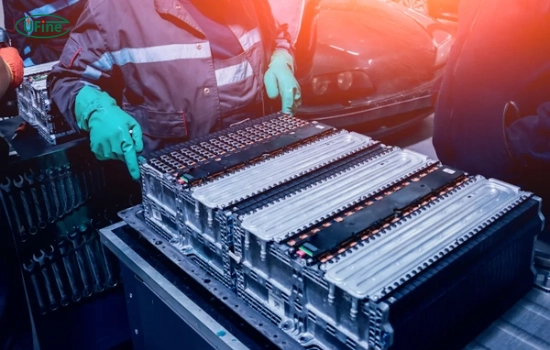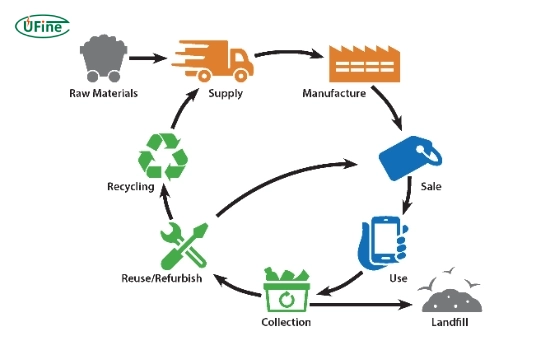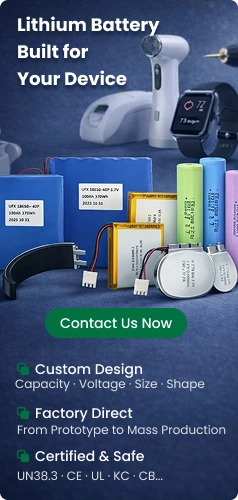
- Part 1. What is a battery management system (BMS)?
- Part 2. Importance of BMS in battery recycling
- Part 3. Key components of a BMS
- Part 4. How BMS affects recycling processes?
- Part 5. Common BMS technologies
- Part 6. Current recycling methods for batteries
- Part 7. Challenges in BMS recycling
- Part 8. FAQs
In recent years, the demand for batteries, particularly lithium-ion batteries, has surged due to the rise of electric vehicles (EVs) and renewable energy storage solutions. As these technologies become more prevalent, the need for effective BMS recycling has gained significant attention. A Battery Management System (BMS) ensures battery safety, efficiency, and longevity. However, as these batteries reach the end of their life cycles, recycling them properly is imperative to recover valuable materials and minimize environmental impact. This comprehensive guide will delve into the intricacies of BMS recycling, exploring its importance, processes, challenges, and prospects.
Part 1. What is a battery management system (BMS)?
A Battery Management System (BMS) is a sophisticated electronic system that manages a rechargeable battery pack. It monitors the battery’s state, controls its environment, and ensures optimal performance. The BMS is crucial for maintaining battery safety, longevity, and efficiency, particularly in lithium-ion technology applications.
Essential functions of a BMS include:
- Voltage Monitoring: Ensuring each cell within the battery pack operates within safe voltage limits.
- Temperature Control: Preventing overheating can lead to battery failure or fires.
- State of Charge (SOC) Estimation: Providing accurate information about the battery’s remaining capacity is vital for effective energy management.
Part 2. Importance of BMS in battery recycling
BMS plays a crucial role in battery recycling. By providing critical data on battery health and performance, a BMS enables recyclers to make informed decisions regarding the recycling process. Understanding the state of a battery allows for a better assessment of whether it should be refurbished, repurposed, or recycled.
Key benefits of BMS in recycling include:
- Enhanced Recovery Rates: By identifying batteries that still have usable life, a BMS can help divert them from recycling processes, allowing for better resource utilization.
- Data-Driven Decisions: The information provided by a BMS aids recyclers in selecting the most effective recycling methods, thus optimizing recovery processes.
- Safety Assurance: Monitoring systems ensure that potentially hazardous batteries are handled safely during recycling.
Part 3. Key components of a BMS
The effectiveness of a BMS in recycling hinges on its core components, which include monitoring, control, and communication systems.
- Monitoring System: This system continuously tracks the voltage, current, and temperature of individual cells, providing real-time data essential for assessing battery health.
- Control System: It manages the charging and discharging cycles, preventing conditions that could lead to battery damage or failure.
- Communication System: This facilitates data exchange between the BMS and other systems, such as charging stations and vehicle control units, ensuring comprehensive battery performance management.
These components collectively contribute to the overall efficiency of BMS recycling by ensuring that batteries are monitored and managed effectively throughout their life cycles.
Part 4. How BMS affects recycling processes?
A well-implemented BMS can significantly streamline recycling processes. Recyclers can determine the most appropriate recycling method by providing detailed insights into the battery’s condition.
For example:
- Identifying Usable Batteries: Batteries that retain a significant charge may be suitable for second-life applications, such as energy storage systems, rather than being sent directly to recycling.
- Optimizing Recycling Techniques: Data from the BMS can inform recyclers about the specific materials in the battery, allowing them to tailor their recycling techniques to maximize material recovery.
- Reducing Environmental Impact: By facilitating the efficient recycling of batteries, a BMS reduces the environmental footprint associated with battery disposal.
Part 5. Common BMS technologies
Different BMS technologies have varying implications for recycling. Understanding these technologies can help identify the most effective recycling strategies.
- Centralized BMS: This design utilizes a single control unit for the entire battery pack, simplifying monitoring and control. However, larger battery systems may need more scalability.
- Distributed BMS: Each cell or group has its controller, allowing for more precise monitoring. This complexity can enhance recycling efforts by providing detailed data on individual cell performance.
- Modular BMS: Combining elements of centralized and distributed systems, modular BMS designs offer flexibility and scalability, which can be advantageous in recycling scenarios.
By understanding these technologies, recyclers can better assess the potential for material recovery and the best practices for processing batteries.
Part 6. Current recycling methods for batteries
BMS recycling involves several established methods, each with its strengths and weaknesses. Understanding these methods is crucial for improving recycling efficiency.
- Mechanical Separation: This method involves physically dismantling batteries to separate components. While effective, it can be labor-intensive and may only recover some valuable materials.
- Pyrometallurgy: This high-temperature process heats batteries to extract metals. While it can recover valuable materials, it is energy-intensive and may produce harmful emissions.
- Hydrometallurgy: This method uses chemical solutions to extract metals from batteries. It is generally more environmentally friendly than pyrometallurgy and can achieve high recovery rates.
Each method contributes to the broader context of BMS recycling, and ongoing research aims to enhance their efficiency and sustainability.
Part 7. Challenges in BMS recycling
Despite its importance, BMS recycling faces several challenges that can hinder effective processes.
- Data Privacy Concerns: Many batteries, particularly those used in consumer electronics, may contain sensitive data. It’s critical to manage this data securely during recycling.
- Physical Handling Risks: Batteries can pose safety risks, including fire hazards. Proper training and equipment are necessary to handle batteries safely during recycling.
- Regulatory Compliance: Navigating the complex landscape of regulations governing battery recycling can be challenging for recyclers, requiring adherence to safety and environmental standards.
Addressing these challenges is essential for improving recycling rates and ensuring safe, effective battery management.
Part 8. FAQs
-
What materials can be recycled from BMS?
Recycling can recover valuable materials such as lithium, nickel, cobalt, and graphite from most lithium-ion batteries. These materials are essential for manufacturing new batteries and other electronic components. -
How does BMS recycling contribute to sustainability?
BMS recycling is crucial to sustainability because it reduces waste and conserves resources. Recovering valuable materials minimizes the need for new raw materials, often involving environmentally damaging extraction processes. -
Are there any regulations for BMS recycling?
Yes, various local and international regulations govern the recycling of battery systems. These regulations ensure safe handling, environmental protection, and resource recovery, promoting responsible recycling practices. -
What role do consumers play in BMS recycling?
Consumers can significantly impact recycling rates by properly disposing of batteries and participating in recycling programs. Increased awareness and engagement can lead to better recycling practices and higher recovery rates. -
How can I find a reliable BMS recycling facility?
Research local recycling programs and look for certifications and reviews to find a reliable BMS recycling facility. Choose facilities that adhere to industry standards and regulations to ensure safe and effective recycling practices.
Related Tags:
More Articles

Battery Load Test: A Comprehensive Guide
Step-by-step battery load test guide for car, solar & industrial use. Learn how to load test a battery, interpret voltage charts, and avoid common mistakes.
The Comprehensive Guide to Battery Balancing and Battery Balancer
Discover how battery balancers improve lithium battery performance, lifespan, and safety. Learn types, functions, and tips to choose the right balancer.
What Is the Best Voltage for a Chainsaw Battery?
Compare 12V-80V chainsaw batteries for light pruning, medium firewood, and professional cutting. See best battery chainsaw with runtime charts and safety tips.
Lithium VS. Alkaline Batteries: A Comprehensive Comparison
Lithium batteries last 3–7× longer than alkaline and perform better in cold weather. Compare lifespan, cost, safety, and best uses to choose the right battery.
Comparing Lithium-Sulfur and Lithium-Ion Batteries: Which is Right for You?
Compare lithium-sulfur (Li-S) and lithium-ion batteries on energy, lifespan, cost, safety, and applications. Best choice for drones, EVs, and electronics.




